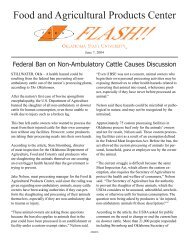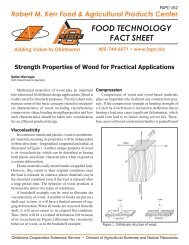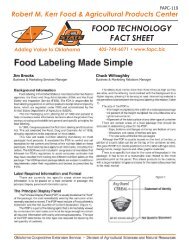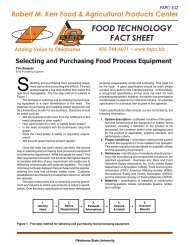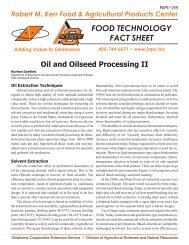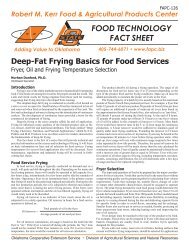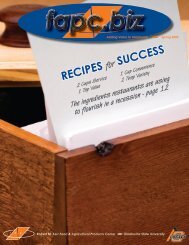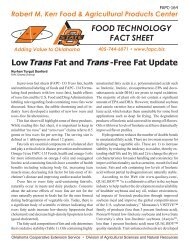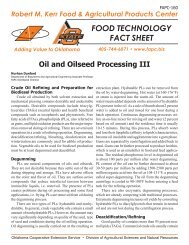2008 Annual Report - Robert M. Kerr Food & Agricultural Products ...
2008 Annual Report - Robert M. Kerr Food & Agricultural Products ...
2008 Annual Report - Robert M. Kerr Food & Agricultural Products ...
You also want an ePaper? Increase the reach of your titles
YUMPU automatically turns print PDFs into web optimized ePapers that Google loves.
Comparison of rheological properties<br />
of wheat cultivars and breeder lines<br />
Objective<br />
The primary objectives of<br />
this study were to assess the<br />
introduction of three methods<br />
of evaluating the viscoelastic<br />
properties of gluten and<br />
dough into the wheat-breeding<br />
program, as well as to compare<br />
the potential of breeder<br />
lines taking into account their<br />
viscoelasticity and extensibility<br />
properties.<br />
Approach<br />
Modern industrial bakeries<br />
demand a balance of<br />
dough strength, extensibility<br />
and viscoelastic properties –<br />
characteristics that indicate<br />
machine-ability and baking<br />
performance. The rheological<br />
properties of two sets of U.S.<br />
hard winter wheat from 2006<br />
and 2007 crop years were analyzed<br />
for viscoelasticity, extensibility<br />
and mixing properties,<br />
wet gluten content, gluten<br />
index, sodium dodecyl sulfate<br />
sedimentation, and baking.<br />
Principal Component<br />
Analysis (PCA), which<br />
enables visualization of twodimensional<br />
relationships in<br />
an otherwise complex, multidimensional<br />
data set, was used<br />
to compare methods of quality<br />
assessment, including Creep-<br />
Recovery, micro-Extension,<br />
and Glutomatic, with traditional<br />
(TRAD) methods used<br />
in wheat breeding laboratories.<br />
Partial PCA with adjustment<br />
for protein content<br />
variation evaluates the extent<br />
of variation of each property as<br />
affected per protein unit. Both<br />
non-adjusted and adjusted<br />
PCAs for CREG methods<br />
20 –– <strong>Robert</strong> M. <strong>Kerr</strong> <strong>Food</strong> & <strong>Agricultural</strong> <strong>Products</strong> Center<br />
give the best discrimination among<br />
the wheat cultivars by explaining the<br />
highest percentage of the sample variation<br />
(with an average of 70 percent in<br />
2006 samples and 66 percent in 2007<br />
samples) compared to the PCAs for<br />
TRAD and ALL (TRAD and CREG)<br />
methods. PCA for traditional and<br />
CREG methods improved visualization<br />
of the interrelation between distinctive<br />
properties (variables) of wheat quality<br />
and thus predicts the usefulness of<br />
introducing new analytical tools to the<br />
breeding program.<br />
Benefits<br />
The quality analysis would improve<br />
the selection of wheat cultivars,<br />
taking into account a multivariate analysis<br />
in which the viscoelastic properties<br />
of gluten and dough are included.<br />
Economic Impact<br />
Derived from the release of new<br />
wheat cultivars with specific improvement<br />
in the viscoelastic properties<br />
of dough, this project is a potential<br />
contributor to the overall revenue of<br />
the Oklahoma <strong>Agricultural</strong> Experiment<br />
Station. These properties are key to<br />
processors in the baking industry.<br />
Continuing Work<br />
Project collaborators plan to apply<br />
these methods to the elite lines<br />
in Dr. Brett Carver’s wheat breeding<br />
program. Then, analysis of the effect<br />
of different crop years using the same<br />
multivariate analysis will begin.<br />
Publications<br />
Output from this project includes<br />
one master’s thesis and two international<br />
meeting presentations.<br />
Funding<br />
The Oklahoma Wheat Commission<br />
and Oklahoma Wheat Research<br />
Foundation provided funding for this<br />
project.<br />
Collaborators<br />
Dr. Patricia Rayas-Duarte, FAPC<br />
cereal chemist, was the principal<br />
investigator for this project. Other<br />
collaborators included PauWei Yeap,<br />
FAPC graduate student; Dr. Steve<br />
Mulvaney, Cornell University food<br />
science professor; Dr. Brett Carver,<br />
plant and soil science regents professor;<br />
and Connie Shelton, plant and soil<br />
science research technician.



